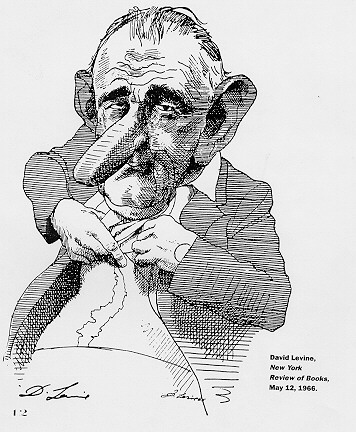
by David Levine, New York Review of Books

by David Levine, New York Review of Books
The following discussion of the above cartoon is excerpted from an episode on Editorial Cartoons from 'Freedom Speaks,' a Freedom Forum television program on First Amendment and media issues. The full text of this episode can be found at: http://www.mediastudies.org/freedomspeaks/510.html.
KERRY BROCK: Hello again. I'm Kerry Brock and welcome back to "Freedom Speaks." The infamous Boss Tweed once said he didn't care so much what the papers wrote about him because his constituents couldn't read, but dammit, he said, they can see pictures. Editorial cartoons have been part of the American political process since Benjamin Franklin drew one back in 1754. They've helped shape and inform public opinion for centuries, often sending stinging messages. This time on "Freedom Speaks" we look at the art and the business of editorial cartooning.
Joining me for today's discussion are Kevin Kallaugher, political cartoonist for the Baltimore Sun and the Economist of London. Joel Pett is the editorial cartoonist at Lexington Herald-Leader in Kentucky. He's also president elect at the Association of American Editorial Cartoonists. And rounding out the talk today, Stephen Hess, author of Drawn and Quartered: The History of American Political Cartoons. Welcome, gentlemen. What makes a good cartoon or a bad cartoon, Steve?
STEPHEN HESS: Well, I would start by saying the fewer words, the better the cartoon. If we looked, for example, at David Levine's cartoon of Lyndon Johnson.
KERRY BROCK: Let's go to that. We've got it now. We've got a lot of cartoons we'll call up during this conversation. That one is entitled "Johnson." [This David Levine cartoon shows Johnson lifting his shirt, exposing a scar in the shape of Vietnam.]
KERRY BROCK: When was that drawn?
STEPHEN HESS: That would have been drawn when Johnson had his gall bladder removed during the Vietnam War. And you see the famous picture of him showing the reporters his gall bladder scar.
KERRY BROCK: Yanked up his shirt in a press conference...
STEPHEN HESS: Showed the gall bladder. And the cartoonist, David Levine of the New York Review of Books, simply changed the scar into Vietnam. And that did it all. No need for any words, no need for any caption. It made that visual imprint. There was the scar on his stomach.
Photo by Charlie
Tasnadi,The Associated Press, from the White House News
Photographers Association (WHNPA) web
page:
http://www.whnpa.org
KERRY BROCK: Would we get it today? The geography of Vietnam was
recognizable.

STEPHEN HESS: Yeah, sure. Oh, of course. Well the cartoon is for today. These gentlemen draw for tomorrow morning. Now this isn't for all of history. When you need to get to history, you need somebody like me to explain it. So that's the important thing.
Click here for more Vietnam-related cartoons by David Levine.